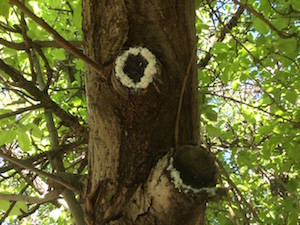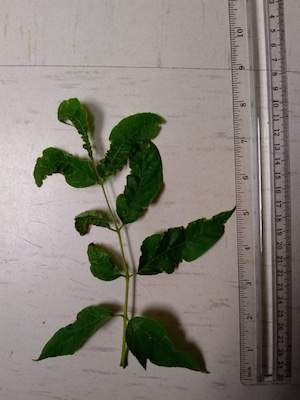 White masses found on the edges of old pruning cuts on this apple tree may be evidence of woolly apple aphid populations. (Photo credit A. Achen)
White masses found on the edges of old pruning cuts on this apple tree may be evidence of woolly apple aphid populations. (Photo credit A. Achen)
Question: What is causing this white webbing that looks like it’s oozing from old pruning cuts in apple trees?
-Aspen Achen, NMSU Extension Agriculture Agent for De Baca County, Fort Sumner, NM
Answer: I had never seen anything like those images of white foamy icing rings around the cut edges where large branches had been removed, so I shared the photos with retired NMSU Extension Horticulture Specialist Dr. Curtis Smith and Joran Viers, City Forester with the City of Albuquerque Parks and Recreation Department. Both responded with a likely culprit: the woolly apple aphid. If so, that white stuff is waxy, filamentous flocculence created by these aphids to make a cozy, protective habitat where they can hide.
The tree owner is encouraged to investigate this material—by “investigate,” I mean remove some of the outer gunk to expose possible aphids underneath—and send a sample down to the NMSU Plant Diagnostic Clinic for free confirmation.
Depending on the severity of the infestation, current life development stage of this pest, and potential resistance some trees and tree cultivars have to woolly apple aphid damage, no action may be necessary to control pest populations. Dislodging the gooey masses with a powerful water spray sounds like my kind of fun. Dr. Smith pointed out that the woolly apple aphid is known for also thriving on root tissues of the host tree and other trees in the vicinity. Luckily, he added, “My apple tree has these aphids and every few years they make an aboveground appearance and then seem gone (hiding underground). My tree has survived them for several decades.”
According to the NMSU Extension publication “Aphids & Their Relatives” by Dr. Carol Sutherland, “Quite a few species of aphids or close relatives of aphids use very different hosts for overwintering and the summer… Woolly apple aphid (Eriosoma lanigerum) causes woody galls on twigs, branches and roots of apple, hawthorn, mountain ash and pyracantha; it may overwinter as nymphs or adults on the roots of plants in the rose family or possibly as eggs on American elm if it is present.”
 Crinkled leaflet margins on this landscape tree may have been caused by aphids. Confirm this possibility by sending affected tissue samples down to the NMSU Plant Diagnostic Clinic through your county Cooperative Extension Service agent. (Photo credit A. Stapp)
Crinkled leaflet margins on this landscape tree may have been caused by aphids. Confirm this possibility by sending affected tissue samples down to the NMSU Plant Diagnostic Clinic through your county Cooperative Extension Service agent. (Photo credit A. Stapp)
Question: A homeowner brought in a bunch of distorted leaves from her ash tree (see photo). Any thoughts?
-Andrea Stapp, NMSU Extension 4-H Agent for Chaves County, Roswell, NM
Answer: Often crinkly, curly leaves (leaflets in this case) can be a sign of aphids or of the damage they have caused. Different aphid species can create very different symptoms (as exhibited above by the flocculent masses created by the woolly apple aphid). Again, it’s best to be sure what we’re dealing with, so please encourage this ash tree owner to submit leaf samples and photos to the NMSU Plant Diagnostic Clinic for verification (see link above). Photos will help determine if the whole canopy is affected or just outer leaves and leaflets. If it is in fact aphid damage, I’m not too worried. They don’t tend to cause more than minor foliage damage, and their populations will come and go throughout the season.
As mentioned above, many aphids may spend winters underground on the roots of a different host species and only affect foliage when new growth emerges in the spring, like having a summer home in the mountains. Dr. Sutherland’s NMSU Extension publication “Aphids & Their Relatives” states that curly leaf aphids (Prociphilus spp.) that dine on “ash foliage in the summer use roots of fir during the winter.”
If it’s not aphid damage, leaf distortion can also be caused by wind and hail, which cannot be easily avoided. This early in the season, leaf damage (whether by the elements or by a bug) is less of a concern because the plant has plenty of time to grow more leaves for adequate photosynthesis (aka making food for itself).
Upcoming activities in a county near you! In the coming month I’ll be visiting Cibola, Grant, Hidalgo, Los Alamos, Rio Arriba, and Sierra Counties for tomato talks, tree walks, and various other gardening pep talks. Information on upcoming events can be found by visiting here.
Send gardening questions to Southwest Yard and Garden - Attn: Dr. Marisa Thompson at desertblooms@nmsu.edu.
Please copy your County Extension Agent and indicate your county of residence when you submit your question!
For more gardening information, visit the NMSU Extension Horticulture page at Desert Blooms.


